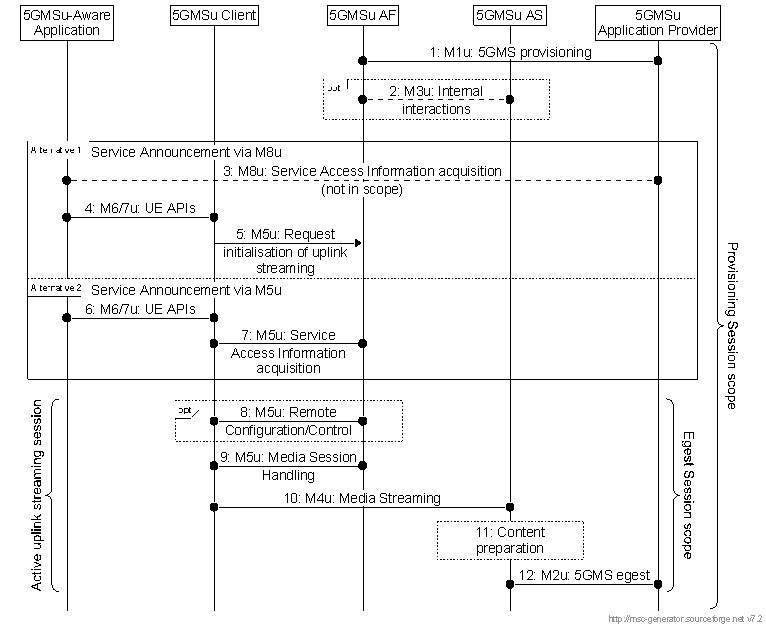Content for TS 26.501 Word version: 18.0.0
1…
4…
4.2…
4.2.2…
4.3…
4.5…
4.6…
4.7…
5…
5.2…
5.3…
5.3.2
5.4…
5.5…
5.5.3…
5.6…
5.7…
5.7.3
5.7.4…
5.8
5.9…
5.10…
5.10.5
5.10.6
5.11…
6…
6.2…
6.3…
6.5…
6.8…
7…
8…
8.2
A…
A.3…
A.5…
A.7…
A.9
A.10
A.11
A.12
A.13
A.14
A.15
B…
B.3
C…
C.3
C.4
C.5
D…
6 Procedures for Uplink Media Streaming p. 85
6.1 General p. 85
The procedures for uplink media streaming allow a 5GMSu Application Provider to create, modify, establish and delete sessions. Uplink media streaming sessions exist between a 5GMSu Client and a 5GMSu AS.
The uplink streaming procedures follow a general high-level workflow, starting from provisioning to the actual uplink streaming sessions. The Egest Session refers to the time period during which media content is uplink streamed to the 5GMSu AS and optionally egested from there to the 5GMS Application Provider. The Provisioning Session refers to the time period during which the 5GMSu Client is permitted to upload stream media content. Interactions between the 5GMSu AF and the 5GMSu Application Provider may occur at any time while the Provisioning Session is active.
The 5GMSu Provisioning API allows the selection of Media Session Handling (M5u) and Uplink Streaming (M4u) options, including whether the media content is published to trusted 5GMSu ASs. The 5GMSu AF selects the M5u interface according to the provisioning option. The Media Session Handling interface exposed by the 5GMSu AF can be used for remote control, metrics reporting, requesting different policy and charging treatments, or 5GMSu AF-based Network Assistance.
When the 5GMSu AF and 5GMSu AS reside in the same DN, then the 5GMSu AF selects the 5GMSu AS. Interactions between a 5GMSu AF and a 5GMSu AS (M3u interactions) take place for Content Egest (M2u) and Uplink Streaming (M4u) resource reservations. The 5GMSu AS allocates M2u and M4u resources and communicates resource identifiers back to the 5GMSu AF. The 5GMSu AF provides information about the provisioned resources (in the form of resource identifiers) for Media Session Handling, Content Egest, and Uplink Streaming to the 5GMSu Application Provider. The resource identifiers for Media Session Handling and Uplink Streaming are needed by the 5GMSu Client to access the selected features.
When 5GMSu AF and 5GMSu AS are operated by different providers, then the M3u interface is not used and the 5GMSu AF does not provide Content Egest (M2u) and Uplink Streaming (M4u) resource reservations. M3u procedures are not specified.
5GMSu Client can (in principle) start the uplink streaming by activating its uplink streaming session. The uplink streaming session for a given UE (or for each UE) is active from the time at which the 5GMSu-Aware Application activates the transmission of an uplink streaming service until its termination.
The 5GMSu-Aware Application receives application metadata from the 5GMSu Application Provider before transmitting the uplink streaming media. The application metadata contains Service Access Information, which acts as an entry point for the 5GMSu Client to start the uplink streaming session. The 5GMSu Client may either receive the Service Access Information from the 5GMSu Application Provider (using a not standardized interface) or instructions for a remote control session. When remote control is activated, then the 5GMSu Client is remotely configured and controlled by a 5GMSu AF.
Figure 6.1-1 provides a basic high-level call flow for uplink streaming. The corresponding collaboration scenario is defined in clause A.10.

Steps:
Step 1.
The 5GMSu Application Provider provisions the 5GMSu AF at reference point M1u, including a Content Publishing Configuration for content egest and, optionally, Content Preparation Templates.
Step 2.
Depending on the provisioned Content Publishing Configuration, the 5GMSu AF might need to interact with the 5GMSu AS to confirm the availability of resources for content preparation.
At some later point in time:
Step 3.
The 5GMSu Application Provider provides Service Access Information to the 5GMS-Aware Application at reference point M8u.
Step 4.
When the 5GMSu-Aware Application decides to activate the streaming service transmission, the Service Access Information is provided to the 5GMSu Client.
Step 5.
The 5GMSu Client requests the 5GMSu AF to initialise uplink media streaming (M5u).
Alternatively:
Then:
Step 8.
If remote control is activated, the 5GMSu AF configures and controls, via M5u, the Media Remote Control sub-function of the 5GMSu Client.
Step 9.
The 5GMSu Client starts the Egest Session by activating the uplink streaming session.
Step 10.
Uplink media streaming starts from the 5GMSu Client to the 5GMSu AS via reference point M4u.
Step 11.
If content preparation was provisioned in step 1, the uplinked media may be manipulated by the 5GMSu AS prior to egest.
Step 12.
Media streaming egest starts from the 5GMSu AS to the 5GMSu Application Provider at reference point M2u.